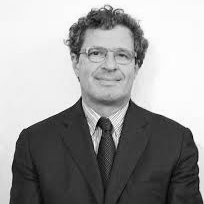This implies analysing what its economic relevance is, assuming that there is a very close connection between economic development and the rational and sustainable use of matter flows. In order to answer this broad research question, it is necessary to mention some changes occurring in our economies.
We shall try to make a list to shed some light on the joint effect of processes holding together economic, social and value changes.
First and foremost we need to analyse the ever-so-pressing issue of the lack of basic raw materials and commodities which is one of the drivers of a radical transformation occurring in the economic system. A recent report by Mc Kinsey (2012) shows how, in just a decade, the real price of commodities has soared by 147% compared to the prices at the onset of the new millennium. Europe is particularly affected by such a situation, because it depends largely on foreign supplies of raw materials. Figure 1 shows such dependence on a series of materials, starting from fossil fuels.
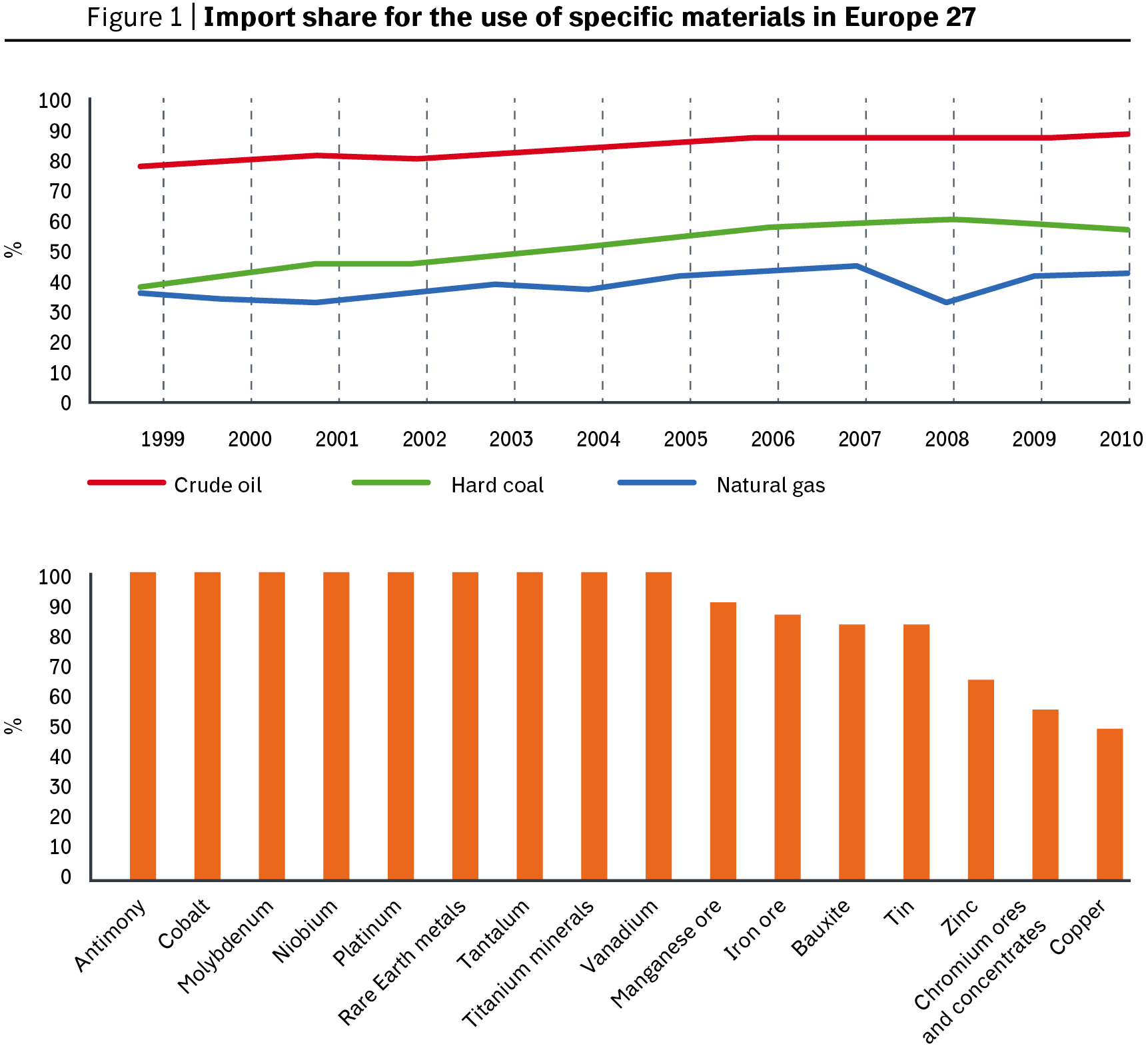 |
|
Source (above): Eurostat Statistics, 2010. Source (below): Raw Materials Initiative Annex, EU 2008. |
Then there is a second driver: a growing interest for a more efficient and renewable use of resources.
Here, over the last few years, the United Nations – mainly through UNEP in 2011, OECD in 2011 and above all the European Commission in 2014 – have emphasized the need to set up a long-term strategy for an efficient use of resources. The European Commission states that “Europe 2020 strategy is one of green growth that not only will help us create a strong economy in the long term, but it also offers real business opportunities to come out of the current crisis and this time in a sustainable way [...] For this transformation to take place eco-innovative solutions will be key. They affect the way resources flow into the economy [...] Innovation tackling systems as a whole and considering value chains in their entirety” (PotoÄnik, 2013).
With regard to this, it is interesting to analyse some data concerning Italy and Europe. In the last decade, Italy has been one of the countries in which the absolute consumption of raw materials has fallen more considerably, around 23%, which accounts for a reduction of 220 million tons of extracted materials from the planet per year. This means that, thanks to the simultaneous reduction of GDP, resources productivity has soared by 35%. Figure 2 shows an analysis of what has happened over the last forty years. Here we see how Italy’s absolute consumption of resources has progressively soared from the 70’s right up to the 90’s, when it started to fall, until it went back to the levels of the early 70’s in 2011 (Bianchi, 2014). The major contributors, rather than the country system with its deliberate strategy, have been the various actors, spurred “to do better with less” by competition and resource scarcity.
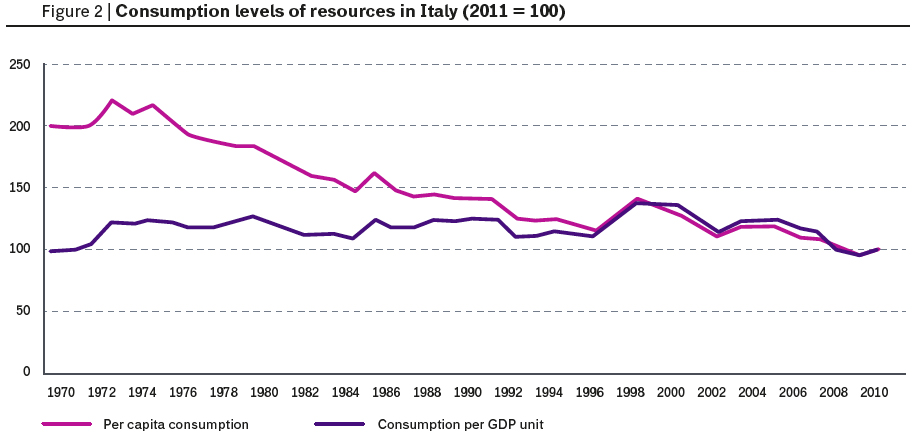 |
|
Source: our estimate on data by Istat and Eurostat (cf. Bianchi 2014). |
Such structural reduction process in the use of materials is taking place in Italy and other countries, such as Germany, Great Britain and Hungary. Generally, in Europe 15, from 2000 to 2009 there was a reduction of 10% in the use of materials, compensated partly (+28% with a net effect of -3%) by the growth characterizing the 12 countries who have lately joined the EU. Overall, the EU went from its peak of 8.3 billion tons of materials in 2007 (almost 17 tons per capita) to 7.3 billion tons in 2009, as a consequence of the crisis and the contraction of investment and infrastructure.
As for the per capita consumption of resources in the various countries, figure 3 shows how the most virtuous countries (The Netherlands, Great Britain, Italy) have a lower per capita consumption among the OECD countries that are now growing both in Europe and worldwide (such as Eastern European countries or Korea) and how, generally speaking, Europe is more efficient compared to other OECD countries. The remarkable differences and the trends in the use of resources amongst the countries is a hot issue for the future.
Together with efficiency there is a third significant process focussed on matter renewability: market growth of bioeconomy products and above all of ever-increasing flows, originating from the reutilization of waste.
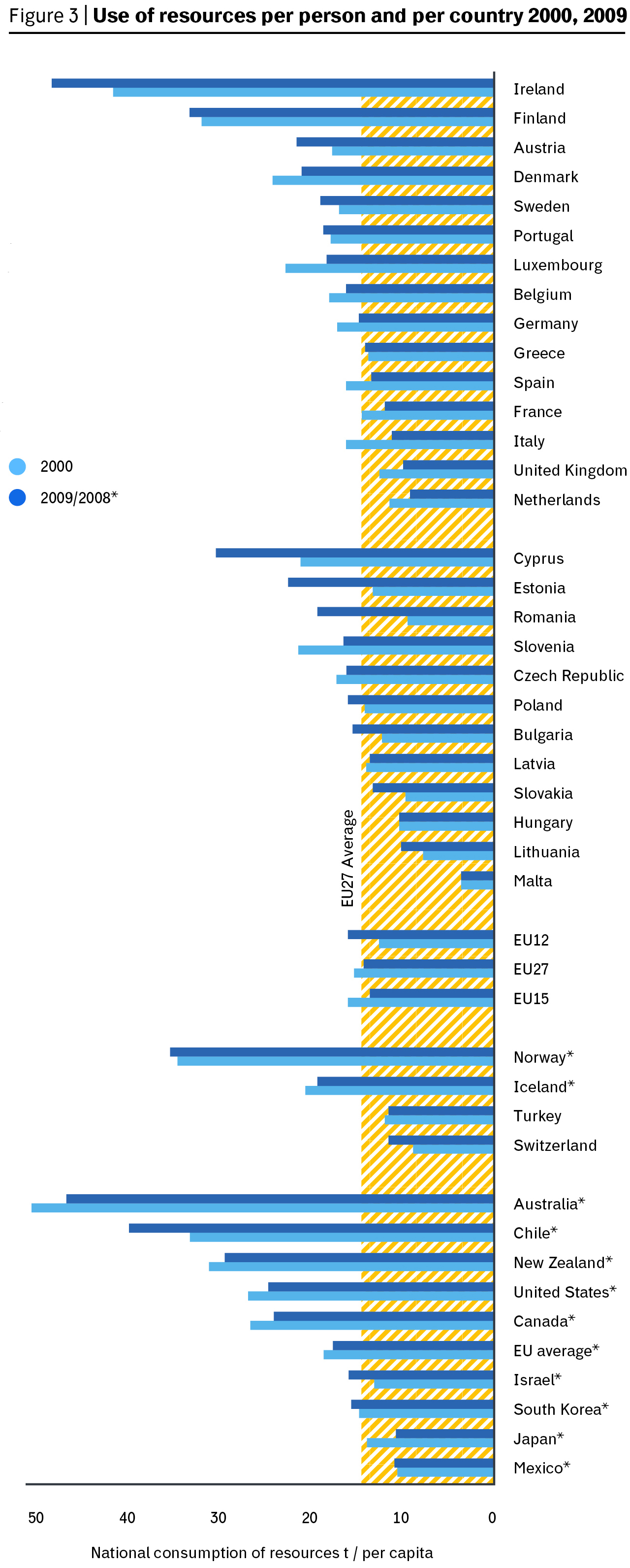 |
|
Source: data on the national consumption of resources from Eurostat Database, Material Flow Accounts, OECD; population data from Eurostat Database, Population and Conference Board – Total Economy Database, 2012 www.conference-board.org/data/economydatabase/. |
The bioeconomy – intended as the production of renewable biobased resources and their transformation together with that of waste flows into added-value products such as foodstuffs, feeds, bioenergies and bioproducts – has been adopted by the European Union as the strategic development line. The market grows by 7% annually (Csse, 2011) and contains highly innovative initiatives such as the Matrìca project green refinery, recently presented at Porto Torres.
As regards (material) waste recycling, the picture is complex and demands a close analysis of the different production chains, which could be carried out within the editorial programme of this magazine with the presentation of significant experiences.
In macroeconomic terms, in order to understand the evolution of this field, the fluctuation of prices and international trade can be taken into consideration. Actually, despite the crisis and augmented availability in the more advanced countries, prices of the main secondary raw materials have almost remained stable in the last decade (figure 4).
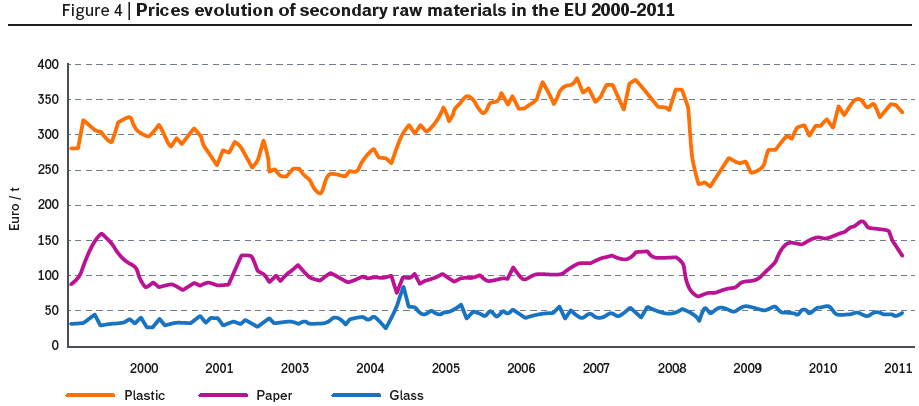 |
|
Source: Etc / Scp based on foreign trade statistics of Eurostat. Note: Prices are calculated as weighed averages of a number of sub-fractions of waste glass, paper and plastic for export within and outside the EU. |
According to the European Environment Agency (2012), in Europe alone, across-the-border waste shipping (mainly special and dangerous) has soared considerably in the last ten years: in 1999, it amounted to around 3 million tons; in 2009, it already reached 11 million. Nations such as France and England, for instance, if they did not export, they could not cope with their high levels of plastic and paper collection, because they are able to reutilize between 50 and 75% within their respective countries. In the near future, it can be expected that countries that today buy secondary raw materials will start sorting waste and reutilize their own discarded materials, thus becoming independent in finding “regenerated” resources. This is precisely why it is imperative that each country develops their own reutilization supply chains, which will in turn feed a “circular” economy able to increase its self-sufficiency in the management of resources.
From this point of view, Italy has a strong industrial tradition in the reutilization of secondary raw materials within the production processes: the textile industry in Prato developed eight hundred years ago on used clothes, Lucchesia’s paper mills have been equipped with the adequate technologies to use pulp for decades, Italy’s metallurgical industry has always used (imported) scrap metals etc.
Other branches have only just recently appeared, such as those of used oils, worn out tyres, of EEEW, of rare earth elements. Nor should we limit our analysis to urban waste, even though it is supported by a recycling system such as that of mandatory consortia. Special waste accounts for 80% of total generated waste and it incorporates most of recycling added value (in 2009, in Europe, as much as 7 billion euros). Much can still be done in this field: let us take EEEW as an example. In Italy, from 2008 to 2010, the amount of waste collected from each citizen per year went from 2.8 to 4.2 kg, a strong increase, but the country is still lagging behind Scandinavian countries that boast up to 15 kg per person.
Another equally significant change is that of the growing complementarity (and thus replacement) of the product with the service. The economic system has now – and this is the fourth factor to consider – a natural tendency towards a growing dematerialization, linked mainly to the service industry (close to 80% of those in work) in the most advanced countries. In the last few years, such servitisation has been accompanied by another significant phenomenon: that of the sharing economy.
Thanks to the Web, more and more industrial products (cars, photocopiers, and also machineries) or goods (such as houses) are hired rather than bought, with better chances of enhancing the materials used and their utilization. It is worth noting that in such collaborative trade mode, whose market was estimated around 110 billion dollars in 2013, benefits can be distributed amongst the various actors along the service chain, both on the supply and demand side. For example, those who shared a house through Airbnb (the company that had over 2.4 million customers in 2012) earn on average 9,300 dollars a year.
And last but not least there is another side to this change linked to the enhancement of the environment (and the ecosystem services) as a key resource for economic development and business activities, in particular in those sectors where the quality of landscape has improved (tourism) or that use natural raw materials. In this respect, water, biomasses, fishing and land uses are some of the key ecosystem resources that make up the basis of the bioeconomy. The effects on the agricultural and food system are tremendous, since companies such as Barilla modify radically their durum wheat supply system (providing incentives for farmers to use crop rotation) because this improves the quality and quantity of production. In this field too, as in the previous one, the changes underway can benefit those on the supply (for instance Barilla) as well as on the demand side (farmers).
Overall, such changing events foreshadow radical innovations in the economic system and a new balance in the use of resources bound to change the components and the nature of products-services, trading modes and reference prices.
Going back to the initial question on how this change is already happening and how significant it is from an economic point of view, all five change processes described above and summed up in figure 5 are becoming increasingly relevant, both in the policy makers’ analyses and in the strategic choices of economic actors.
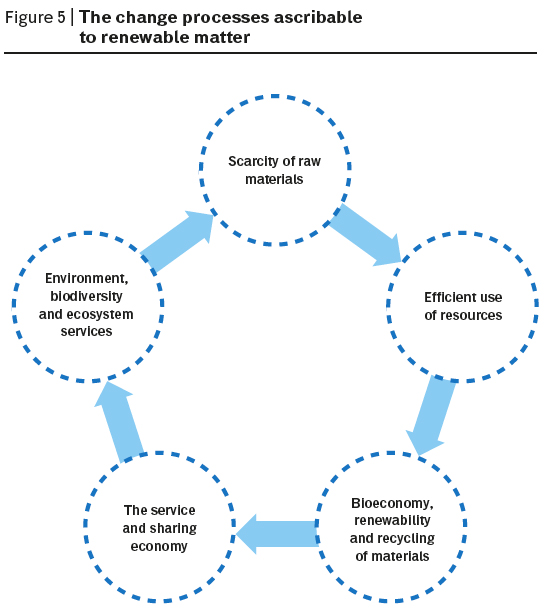
After all, these processes are interconnected and require – in order to fully express their innovative potential – a strategic vision of the evolution of the economic system where the action of policy makers must be accompanied by investments in the private sector and by a transformation of lifestyles and consumption habits (a crucial issue only barely touched upon in this paper).
For example, the last process described in the analysis, that integrating the environment with biodiversity and the ecosystem services, is represented in figure 5 as having a clear position in a global economic cycle linking these variables to the sharing economy and to the material flow. It is an apparently simple logical connection, but it implies going beyond a set of knowledge and policy limitations necessary to face, in an integrated way, the main economic trends characterizing the next decades.
Such representation requires an integrating and complex effort of monetizable factors with non-monetizable ones, of economic parameters with social processes, of network and multi-instrumental modalities of governance. For these reasons, in the next decades, the economy will have to operate an analysis shift. This magazine will try to offer a contribution towards this change. In the next issues the underlying arguments of these ongoing change processes will be further illustrated, in order to equip readers with better ability to interpret the economy of renewable matter.
Bibliography
European Environment Agency (2012), Material Resources and Waste, 2012 update, EEA, Copenaghen
Bianchi D. (2014), “Introduzione”, in Ambiente Italia 2014, Edizioni Ambiente
EC (2014), Com 398 “Communication from the Commission to the European Parliament, the Council, the European Economic and Social Committee and the Committee of the Regions – Towards a circular economy: A zero waste programme for Europe”, EC, 2 July 2014
Csse (2011), Final Evaluation of the Lead Market Initiative, July, 2011
McKinsey (2012), Mobilizing for a Resource Revolution, McKinsey Quaterly, January
OECD (2011), Towards Green Growth: A Summary for Policy Makers, OECD, Paris
PotoÄnik (2013), Speech at the European Innovation Summit, Brussels, 30th September 2013
UNEP (2010), Green Economy Developing Countries Success Stories, UNEP, Geneva


